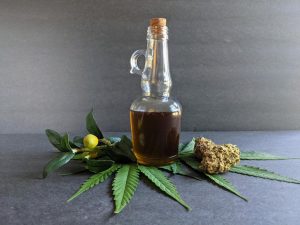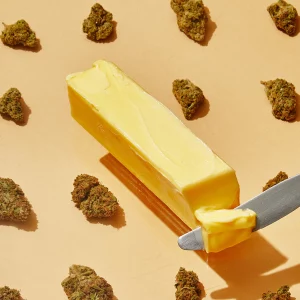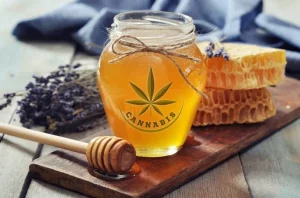Written By: Faith Steele
Making edibles is not necessarily hard, but it does have a few extra steps compared to just following a standard recipe. Almost all recipes can be altered into a edible, but before you start dumping your weed into a batch of brownies and calling it a day, we have to start with the infusions process, and before that the decarboxylation process as well.
Now I know some of you are thinking “But Faith! Decarboxylation is a big word, and that sounds like a lot of extra steps!” and you’re right, it is a big word, so I am going to shorten it to “decarb” for the rest of the article.
 In all seriousness, these two steps are very easy and ultimately just require time and some patience. There are a plethora of ways to decarb your cannabis, but no matter what method you go with the process will take any where between 30 minutes to four hours to complete.
In all seriousness, these two steps are very easy and ultimately just require time and some patience. There are a plethora of ways to decarb your cannabis, but no matter what method you go with the process will take any where between 30 minutes to four hours to complete.
The method you choose is entirely up to you, but if you decide to use cannabis extracts to make your edibles I would recommend the oven method, or the Ardent Nova decarboxylator (available at your local Nectar) if you get really serious about your homemade edibles, as it boasts a 97% potency retention and is designed for ease of use. These two methods are the least messy when decarbing extracts, and in my opinion the easiest as well.
Once you’ve activated the THC, it is time to start making the infusions that you plan to use in your recipe. In theory, once your cannabis is decarbed you could just mix it into any recipe you are making, but with that being said, I would highly advise against this: It would not taste good, and THC becomes more bio-available when bonded to fat, which is a fancy way of saying it will get you higher.
Most infusions are simple but the process can take some time, so I recommend getting set up with a movie or catching up with that new series your friends keep telling you to watch that you’ve been putting off. Most infusions are simple to make and start out the same, so for a basic infusion, you’ll need:
Ingredients:
3.5g – 7g of decarbed flower (or 1g of decarbed extract) per cup of Cannabis carrier
Enough Cannabis carrier for the amount of flower/extracts
Equipment:
*Cheese cloth and Cooking twine (For flower infusions)
Sauce pan
Candy thermometer
*If you are using decarbed flower for your infusions, I like to tie it up in cheese cloth (like a tea bag) before I add it into the carrier to minimize the amount of loose flower left behind in the infusion. A fine mesh strainer will work as well.
Place your carrier into the sauce pan over the recommended heat for the infusions (use the candy thermometer). Add your decarbed cannabis and wait. Once done, squeeze as much as you can out of your decarbed flower as to not waste the infusions.
Now, depending on the carrier:
Butter Infusions
160° F for two hours
Butter is probably the easiest thing to utilize for infusions, and using a cannabis infused butter in my experience has made the best homemade edibles. The only real downside to using this infusion is that whatever recipe you are making needs to have a good amount of butter in it for the edibles to be effective.
Oil Infusions
160° F for four hours
Almost any oil can be used, however you should keep in mind that some oils will absorb THC better than others. Coconut oil and olive oil seem to absorb THC the best, where vegetable and avocado oil infusions may not absorb THC as well (however they can still be utilized as some recipes call for specific oils).
Milk and Cream Infusions
150° F for two hours

A good rule of thumb when dealing with cream or milk is to keep the temperature low. I would recommend using a double boiler to keep the milk or cream from burning; Just remember to check the water level of your double boiler through out the process.
Since the goal is to bind THC to fat with these infusions, using a high fat content milk, or heavy cream will produce the best results.
Honey Infusions
150° F for 2-4 hours*
Since honey has no fat for the THC to bind to, it is important that you add two Tablespoons of coconut MCT oil for every cup of honey you are infusing if you want a potent end result. Once finished, use a blender to whip the honey for a few minutes to make sure the oil and honey are emulsified.
*The longer you infuse for, the more potent your honey will be
While they will work, I do not recommend these next infusions if you recipe contains the above ones, as they do not have any fat for the THC to bind to:
Alcohol Infusions
This is essentially how to make an alcohol based tincture, and is the first step in making the next infusion. If you are making this to be a base ingredient, always use everclear but if you just want an infused liquor feel free to use what ever you want. Add your decarbed cannabis to your alcohol and store it in a cool dark place for 1+ months, shaking vigorously once a day or so.
Note: You can use heat to speed up the process, but I do not advise this unless you know what you are doing, as alcohol is extremely flammable
Sugar Infusions
I think infused sugar is best used for your morning coffee, however many people love cooking with it. Once you’ve made your alcohol tincture from above, mix ¼ cup of the tincture for every cup of sugar you are infusing, and spread out onto a lined baking sheet. Place in a 200 oven, removing every 15 minutes to stir the mixture around until all the alcohol has evaporated. It may be a little clumped together or a little grainy at this point, and if so you can pulse it in a blender a few times to get the desired consistency.
Note: make sure you make your tincture with everclear, as most other alcohols have too high of a water content for this to work.
Flour Infusions
Not really an infusion, this is my least favorite item on the list, as it can change the consistency of a recipe and does not taste great. Using a motor and pestle, grind up your decarbed flower until it is close to the same consistency of flour. Mix together equal parts of your decarbed cannabis with flour using a whisk.
One of the most daunting parts about making homemade edibles is finding out how to actually get your cannabis into your recipe. These are the infusions that have helped me achieve an end result that not only tastes great, but gives you the strong effects you are after, and I hope they help you feel more confident experimenting with cannabis in your kitchen.
Cooking can be a very rewarding experience, and with some time and effort you may be shocked at how much you enjoy it, especially when you add cannabis. If this article has further piqued your interest in cooking with cannabis then check out our Cannachef Article so you can learn and witness the experts in the number #1 cannabis cooking competition in the PNW!!



